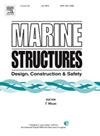Water impact damage considering hydro-plastic interactions: Extensive experimental and numerical validation, and structural design recommendations
IF 4
2区 工程技术
Q1 ENGINEERING, CIVIL
引用次数: 0
Abstract
Water impact damage can occur for ocean structures subjected to extreme waves as well as aeronautical vehicles during emergency water landing. The problem involves complicated fluid structure interaction (FSI) effects between large plastic structural deformations and fluid flow pressures, known as hydro-plasticity, and is not well understood. In 2019, we (Yu et al. [1]) derived a novel hydroplastic solution for water impact damage of beams and stiffened panels considering the mutual coupling effect. This paper utilizes results from model tests, real world wave impact accidents and coupled FSI numerical simulations to verify comprehensively the accuracy of the hydroplastic model in terms of the predicted structural damage and pressure histories. As most design standards use suggested pressure curves for designing against extreme wave impacts in the maritime and offshore industries, the pressure histories predicted by the hydroplastic model are reapplied to the structures to calculate the structural responses using nonlinear finite element analysis (NLFEA). This is to test if the generated pressure histories can reproduce the water impact damage and be used as suggested design pressure curves. Finally, a new design method is suggested based on the hydroplastic slamming model for the design of ocean structures against extreme wave impacts. The proposed design approach suggests using impact velocities rather than design pressures in current design standards, as the main design parameter, the value of which should meet required annual exceedance probability levels. The proposed design approach represents clear improvement and is useful for reliable and cost-effective design of structures against extreme water impacts.
考虑水塑性相互作用的水冲击损伤:广泛的实验和数值验证,以及结构设计建议
在极端波浪作用下的海洋结构物以及航空飞行器在紧急水上着陆时都可能发生水冲击损伤。该问题涉及大塑性结构变形和流体流动压力之间复杂的流体结构相互作用(FSI)效应,称为水塑性,目前尚未得到很好的理解。2019年,我们(Yu et al.[1])推导了一种考虑相互耦合效应的梁和加筋板水冲击损伤的新型水塑性解决方案。本文利用模型试验、真实世界波浪冲击事故和耦合FSI数值模拟的结果,全面验证了水塑性模型在预测结构损伤和压力历史方面的准确性。由于大多数设计标准使用建议的压力曲线来设计海事和海洋工业中的极端波浪冲击,因此将水塑性模型预测的压力历史重新应用于结构,并使用非线性有限元分析(NLFEA)计算结构响应。这是为了测试生成的压力历史是否可以再现水冲击损伤,并作为建议的设计压力曲线使用。最后,提出了一种基于水塑性冲击模型的海洋结构物抗极端波浪冲击设计新方法。建议的设计方法建议使用冲击速度而不是现行设计标准中的设计压力作为主要设计参数,其值应满足要求的年度超过概率水平。所提出的设计方法有明显的改进,有助于可靠和经济地设计抵御极端水影响的结构。
本文章由计算机程序翻译,如有差异,请以英文原文为准。
求助全文
约1分钟内获得全文
求助全文
来源期刊

Marine Structures
工程技术-工程:海洋
CiteScore
8.70
自引率
7.70%
发文量
157
审稿时长
6.4 months
期刊介绍:
This journal aims to provide a medium for presentation and discussion of the latest developments in research, design, fabrication and in-service experience relating to marine structures, i.e., all structures of steel, concrete, light alloy or composite construction having an interface with the sea, including ships, fixed and mobile offshore platforms, submarine and submersibles, pipelines, subsea systems for shallow and deep ocean operations and coastal structures such as piers.
 求助内容:
求助内容: 应助结果提醒方式:
应助结果提醒方式:


